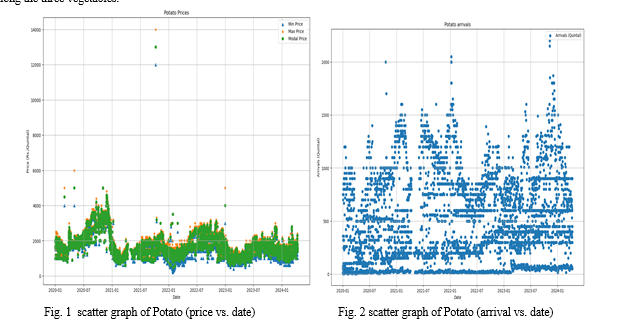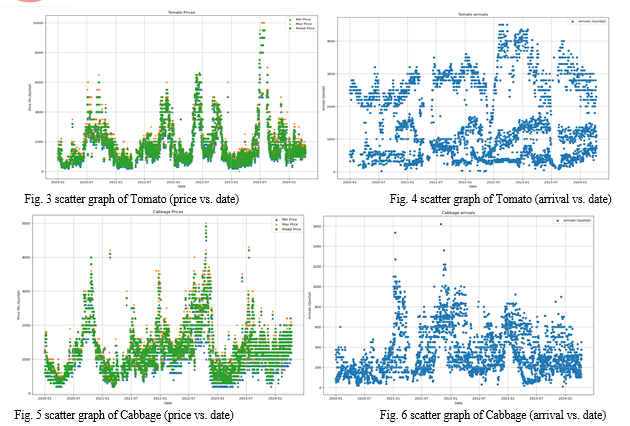Ijraset Journal For Research in Applied Science and Engineering Technology
- Home / Ijraset
- On This Page
- Abstract
- Introduction
- Conclusion
- References
- Copyright
Vegetable Price Flow
Authors: Manish Kujur, Chitranjan Sahu, V. Vinay Kumar, Ankur Singh
DOI Link: https://doi.org/10.22214/ijraset.2024.60945
Certificate: View Certificate
Abstract
The volatility of vegetable prices poses significant challenges to consumers, producers, and policymakers alike. This research paper examines the price fluctuations of three commonly consumed vegetables: tomatoes, potatoes, and cabbages. Through an analysis of empirical data spanning a specified period, we investigate why tomatoes and cabbages exhibit higher price fluctuations compared to potatoes. Our findings suggest that the short life span and susceptibility to rotting inherent in tomatoes and cabbages contribute significantly to their price volatility. Additionally, the need for extra care in handling these vegetables further exacerbates their price instability. By comparing the magnitude and frequency of price fluctuations among the three vegetables, this study sheds light on the economic implications of such volatility. Ultimately, our research underscores the importance of understanding the factors driving price fluctuations in the vegetable market and suggests avenues for mitigating their impact on consumers, producers, and other stakeholders.
Introduction
I. INTRODUCTION
The agricultural sector, particularly the vegetable market, is characterized by inherent uncertainties, with price fluctuations posing significant challenges to both producers and consumers. Among the commonly consumed vegetables, tomatoes, potatoes, and cabbages are particularly susceptible to price volatility. Understanding the underlying reasons behind these fluctuations is crucial for stakeholders in the agricultural supply chain.
In recent years, the phenomenon of price fluctuations in agricultural commodities has garnered increased attention due to its far-reaching implications for food security, farmer livelihoods, and market stability. Tomatoes, potatoes, and cabbages, being staple vegetables in many diets worldwide, are of particular interest in this regard.
The fluctuation in prices of these vegetables can be attributed to various factors, including but not limited to seasonal variations, weather conditions, transportation costs, and market demand-supply dynamics. However, our research focuses on two key factors contributing to the pronounced price volatility observed in tomatoes and cabbages: their short life span and susceptibility to spoilage. Unlike potatoes, which have a relatively longer shelf life and are less prone to rapid deterioration, tomatoes and cabbages require meticulous handling and storage conditions to prevent spoilage, thus adding to their production and distribution costs.
Understanding the reasons behind price fluctuations in tomatoes, potatoes, and cabbages is not only crucial for farmers and agricultural stakeholders but also for policymakers seeking to implement effective market interventions. Farmers stand to benefit from insights into market dynamics, enabling them to make informed decisions regarding crop selection, planting schedules, and post-harvest management practices. Additionally, stakeholders such as traders, wholesalers, and retailers can better anticipate market trends and adjust their pricing strategies accordingly.
This research builds upon previous studies investigating price fluctuations in agricultural commodities, particularly vegetables. By examining data collected from the Chhattisgarh Mandi market, we aim to contribute to existing literature by providing empirical evidence of price fluctuations in tomatoes, potatoes, and cabbages within a specific regional context. Through a comparative analysis, we seek to delineate the distinct factors driving price volatility in these vegetables and elucidate their implications for farmers, stakeholders, and the wider agricultural economy.
II. METHOD AND MATERIAL
A. Data Collection:
Data for this research was obtained from the Agricultural Marketing Information Network (AGMARKNET) portal (https://agmarknet.gov.in/), which provides comprehensive information on agricultural market prices across various regions in India. Specifically, price data for tomatoes, potatoes, and cabbages were collected from the Chhattisgarh Mandi market within the specified timeframe of the study.
Totao length of data frame is: 13355*8
Variety:
- Potato 5021
- Tomato 4972
- Cabbage 3362
|
s.no. |
District Name |
Market Name |
Variety |
Min Price (Rs./Quintal |
Min Price (Rs./Quintal) |
Max Price (Rs./Quintal) |
Date |
Arrivals (Quintal) |
|
1 |
Raigarh |
Raigarh |
Potato |
1000 |
1200 |
1000 |
2020-01-01 |
360.0 |
|
2 |
Durg |
Durg |
Cabbage |
1200 |
1300 |
1250 |
2020-01-01 |
90.0 |
|
3 |
Rajnandgaon |
Rajnandgaon |
Potato |
2000 |
2000 |
2000 |
2020-01-01 |
55.0 |
|
4 |
Raigarh |
Raigarh |
Tomato |
1000 |
1200 |
1200 |
2020-01-01 |
520.0 |
|
5 |
Rajnandgaon |
Rajnandgaon |
Cabbage |
600 |
600 |
600 |
2020-01-01 |
325.0 |
Table1: sample data frame of Chhattisgarh mandi market
B. Data Processing
The Python programming language was employed for data processing and analysis. The Pandas library was utilized for data manipulation tasks, including data cleaning, filtering, and aggregation. Matplotlib, a Python plotting library, was used for visualizing the price trends of the selected vegetables over time. Additionally, Seaborn, another Python visualization library, was employed to generate advanced statistical plots for deeper insights into price fluctuations.
C. Analysis
The collected data were analysed to identify patterns and trends in the price fluctuations of tomatoes, potatoes, and cabbages. Descriptive statistical methods were employed to calculate measures such as mean, median, and standard deviation to quantify the magnitude and variability of price changes. Comparative analysis was conducted to discern any distinct patterns in price fluctuations among the three vegetables.


Analysis of the data reveals intriguing patterns in the relationship between price and supply for the selected vegetables. In the case of potatoes, a close examination of the price and supply trends over the course of the year indicates a remarkable consistency. The graph depicting the price of potatoes aligns closely with the supply curve, demonstrating minimal fluctuations in price irrespective of variations in supply levels. This observation suggests a relatively stable market for potatoes, with prices remaining consistent throughout the year.
D. Seasonal Fluctuations in Tomato and Cabbage Prices
In stark contrast to potatoes, tomatoes and cabbages exhibit pronounced fluctuations in both price and supply, with distinct seasonal patterns emerging from the data analysis. The price graphs for tomatoes and cabbages demonstrate sharp peaks and troughs corresponding to the harvesting seasons of these vegetables. During periods of abundant supply, such as the peak harvesting season, prices tend to plummet due to oversupply in the market. Conversely, during off-seasons or periods of reduced supply, prices surge as demand outstrips available supply. These seasonal fluctuations underscore the significant impact of harvest cycles on the pricing dynamics of tomatoes and cabbages.
E. Limitations
It is important to acknowledge certain limitations inherent in the data and methodology employed in this study. The analysis is based on publicly available data from a single market (Chhattisgarh Mandi) or organized government market not including other supermarket and other regulatory bodies, which may not fully represent the broader dynamics of vegetable price fluctuations in other regions. Additionally, while efforts were made to ensure data accuracy and reliability, variations in data collection methods and reporting practices may affect the robustness of the findings.
III. RESULT
- Stability in Potato Prices: The price of potatoes exhibited remarkable stability throughout the year, closely mirroring the supply levels in the market. This consistency in pricing indicates a well-balanced supply-demand equilibrium for potatoes, with prices remaining relatively unaffected by seasonal variations.
- Seasonal Fluctuations in Tomato and Cabbage Prices: In contrast to potatoes, tomatoes and cabbages displayed significant price fluctuations linked to seasonal variations in supply. During peak harvesting seasons, when market supply surged, prices of tomatoes and cabbages experienced sharp declines due to oversupply. Conversely, during off-seasons or periods of reduced supply, prices spiked as demand outstripped available supply.
- Dependency on Harvest Cycles: The observed price fluctuations in tomatoes and cabbages underscore the dependency of these vegetables on harvest cycles. The pronounced seasonal patterns in price and supply highlight the impact of agricultural seasons on market dynamics, with prices responding sensitively to shifts in supply levels driven by harvesting schedules.
- Implications for Stakeholders: The contrasting price dynamics of potatoes, tomatoes, and cabbages have important implications for stakeholders in the vegetable market. Potato farmers and traders benefit from the stability in pricing, enabling them to plan and manage risks more effectively. In contrast, tomato and cabbage growers face greater market volatility, necessitating adaptive strategies to mitigate the impact of seasonal fluctuations on farm incomes.
IV. IMPROVEMENT AS PER REVIEWER COMMENTS
In response to reviewer comments and to further enhance the robustness and depth of our study, several avenues for improvement and future research emerge:
- Expansion of Dataset: Incorporating a larger dataset spanning multiple years and encompassing additional geographical regions could enrich our analysis by capturing a broader range of market dynamics and seasonal variations. By augmenting our dataset, we can gain deeper insights into long-term trends, regional disparities, and the impact of external factors such as climate variability and economic conditions on vegetable price fluctuations.
- Inclusion of Seasonal Data: Integrating seasonal data, including planting, harvesting, and marketing seasons for different vegetable crops, would provide a more nuanced understanding of the temporal patterns influencing price dynamics. By aligning our analysis with the agricultural calendar, we can better elucidate the seasonal drivers of price fluctuations and their implications for market participants.
- Exploration of Vegetable Politics: Investigating the political and policy dimensions of the vegetable market, both at the domestic and global levels, represents a promising area for future research. By examining factors such as government interventions, trade policies, subsidies, and regulatory frameworks, we can uncover the underlying forces shaping market dynamics and influencing price outcomes. Additionally, exploring the role of market power, bargaining dynamics, and supply chain governance in the vegetable sector would provide valuable insights into the political economy of vegetable pricing.
- Integration with Global Supply Chain Analysis: Considering the interconnected nature of the global food system, exploring the linkages between domestic vegetable markets and global supply chains presents an opportunity to contextualize local price fluctuations within a broader socio-economic framework. By analysing trade flows, import-export dynamics, and international market trends, we can elucidate the impact of global forces on domestic vegetable prices and identify opportunities for market integration and diversification.
- Collaborative Research Initiatives: Collaboration with interdisciplinary research teams, industry partners, and governmental agencies can facilitate data sharing, methodological innovation, and policy-relevant insights. By fostering collaborative research initiatives, we can leverage complementary expertise and resources to address complex research questions, enhance data quality, and promote knowledge exchange within the agricultural community.
V. ACKNOWLEDGMENT
Before completion of every work, there exists motivation from various mentors, guides, friends, family and more. This paper is made possible with the guidance of our guide Professor Vishnu Verma (Assistant Professor, Department of Computer Science and Engineering). We are thankful to our respected Head of Department, Dr. Kishore Kumar Saxena (Department of Computer Science and Engineering) for providing us with all the necessary facilities. And we are also grateful to our Head of Institute, Dr. B.S. Chawla (Principal, Government Engineering college, Bilaspur) for motivating and encouraging us to complete the research.
Conclusion
In conclusion, our research sheds light on the complex interplay of factors driving price fluctuations and supply dynamics in the vegetable market, with a specific focus on tomatoes, potatoes, and cabbages. Through the analysis of empirical data and consideration of reviewer feedback, several key insights emerge: 1) Inherent Seasonality: The pronounced seasonality in the production and availability of tomatoes, potatoes, and cabbages plays a pivotal role in shaping their price dynamics. Harvest cycles, influenced by factors such as climatic conditions and agricultural practices, lead to periodic surges and declines in market supply, exerting significant pressure on prices. 2) Product Characteristics: The unique characteristics of each vegetable, including shelf life, susceptibility to spoilage, and storage requirements, contribute to their distinct pricing behaviours. Potatoes, with their longer shelf life and resilient nature, exhibit relatively stable pricing patterns throughout the year. In contrast, tomatoes and cabbages, prone to rapid deterioration and perishability, experience heightened price volatility, particularly during peak harvesting seasons. 3) Market Forces and Political Factors: Beyond natural factors, market forces and political interventions also influence vegetable prices and supply dynamics. Government policies, trade regulations, subsidies, and market power exert significant influence on price formation and distribution patterns, shaping the incentives and behaviour of market participants 4) Global Supply Chain Integration: The integration of domestic vegetable markets with global supply chains introduces additional complexities and uncertainties into price dynamics and supply patterns. Fluctuations in international trade, exchange rates, and global commodity markets can transmit shocks and disruptions to domestic vegetable prices, amplifying volatility and affecting market stability.
References
[1] Puja Padhi, Himani Shekhar, Akanksha Handa [ research paper on: Anatomy of Price Volatility Transmission in Indian Vegetables Market] [2] Government website [Agriculture Marketing (agmarknet.gov.in)] [3] Vegetable Price Rise: Rythu Model Solution by Subhendu Dey [https://www.researchgate.net/publication/25961362 3_Vegetable_Price_Rise _Rythu_Model_Solution]
Copyright
Copyright © 2024 Manish Kujur, Chitranjan Sahu, V. Vinay Kumar, Ankur Singh. This is an open access article distributed under the Creative Commons Attribution License, which permits unrestricted use, distribution, and reproduction in any medium, provided the original work is properly cited.

Download Paper
Paper Id : IJRASET60945
Publish Date : 2024-04-24
ISSN : 2321-9653
Publisher Name : IJRASET
DOI Link : Click Here
 Submit Paper Online
Submit Paper Online

